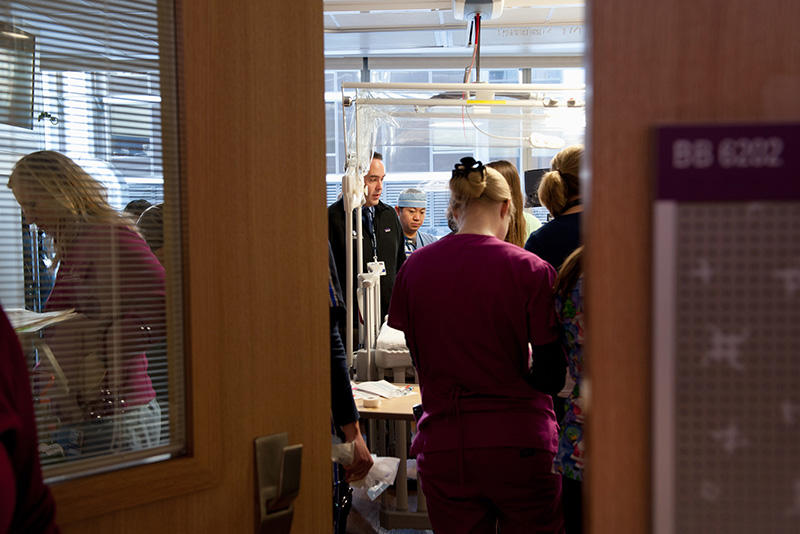Nurses find simulation to be a core component of daily care delivery

Complex patients, new technology, a demanding health care environment. These factors and more underscore the growing importance of simulation as a key component of nurses’ education and training. At Boston Children’s Hospital, nurses use simulation to hone skills, refine experience, improve interprofessional communication, and expand competence and confidence. Simulation is a core component of their training and daily care delivery.
Collaborating with SIMPeds experts
Nursing Professional Development (NPD) practitioners partner with Boston Children’s Pediatric Simulator Program (SIMPeds) to lead efforts throughout the hospital to optimize care, experiences, and outcomes through lifelike, immersive preparation and training. Since 2001, nurses have leveraged and innovated simulation technology touching every specialty and thousands of staff with value-driven activities aimed at enterprise-wide problem-solving – from skills and team training, to systems testing, to patient-specific engineering of devices. “Mentorship and education are at the very DNA of nursing, and since our beginnings, SIMPeds has been proud to partner so deeply to create world class health care at Boston Children’s,” says Peter Weinstock, MD, PhD, SIMPeds executive director.
In the SIMPeds Surgical Services Nursing Program, associate director Shelly Pignataro, MSN, RN, NPD-BC, professional development specialist, uses simulation to validate new nurses’ skills such as central venous catheter care, tracheostomy management, and how to care for a deteriorating patient. Simulation is also useful to perform annual competency assessments for Basic Life Support and Pediatric Early Assessment, Recognition and Stabilization. Pignataro uses it to develop nurses’ advanced critical thinking and reinforce the principles of high reliability, as well.
Teresa Shannon, MSN, RN, CPN, professional development specialist, associate director for SIMPeds-Nursing, trains nearly 200 nurses on Boston Children’s inpatient medicine nursing units annually. Nurses receive skills refresher training and participate in simulated emergency scenarios and debrief sessions. “Our goal is to enhance nurses’ abilities to recognize, react and report in these critical situations,” says Shannon. “The questions nurses raise, and the experiences and knowledge they share during simulation training enrich their learning experience. Nurses tell us this training has improved their confidence caring for at-risk patients.”
Simulation is a core element of nursing orientation in the Medical Intensive Care Unit (MICU). Michelle Gist, BSN, RN, CCRN, clinical nurse educator, associate clinical director, SIMPeds MICU Nursing Programs, facilitates training for the interprofessional MICU team, with a focus on CRM and high reliability. On the Biocontainment Unit, Gist conducts education around pediatric protocols and guidelines for safe care of patients with infectious diseases such as Ebola. Simulation is then used to validate and adjust the guidelines.
Simulation training is more important than ever to meet the challenges of COVID-19, says Matthew Taylor, RN, curriculum development manager, SIMPeds. “Nurses in Critical Care, Perioperative Services, the Cath Lab, MRI/CT, Cardiology and many other departments partner with us to rapidly design simulation to test processes, and develop maps and reference guides to prepare colleagues for every eventuality.”
A safe space for hands-on learning
Simulation is a key part of training for every newly licensed nurse at Boston Children’s. In the Transition to Nursing Practice (TNP) Program, simulation helps new nurses move from the academic to the clinical setting with confidence. Training focuses on communication in stressful situations, critical thinking in emergencies and learning to function as part of a team. “We provide a safe space to practice skills and participate in common pediatric scenarios,” says Lauren Danforth, MSN, RN, NPD-BC, nursing professional development specialist, and TNP program director. “Repetition helps new nurses gain competence and transition to the role of professional nurse.”
Optimizing care for autism patients
Dennis Doherty, MSN, RN, NPD-BC, nursing professional development specialist, Kristin Coffey, MS, CCLS, child life specialist, and actors from the Harvard Medical School Clerkship Program facilitate the enterprise-wide Interprofessional Collaboration to Care for Patients with Autism Spectrum Disorder (ASD). They use simulation to help caregivers improve encounters with the growing ASD population. Nurses, physicians, child life specialists, counselors, clinical assistants, and physical and occupational therapists participate. Training focuses on planning, communication, accommodation and respect. Interprofessional teams huddle to plan their approach, practice their responses to challenging behaviors, and meet afterward to debrief.
“Our interprofessional focus is innovative, and ensures that participants benefit from a wide range of expertise,” says Doherty. “In addition, Boston Children’s is one of the first hospitals to use actors to simulate the experience of caring for patients with ASD.”
Instilling lifelong competence
In the Cardiac Intensive Care Unit, clinical nurse educators Shannon Olbrot, BS, BSN, RN, CCRN, Toni Imprescia, BSN, RN, CCRN, Michael Greenlee, BSN, RN, CCRN, and Suzanne Colonna, RN, CCRN use simulation to train nurses at all levels – from new hires to seasoned professionals. They start with basics such as airway management, medication administration, infusion and defibrillator skills, and progress to more complex scenarios such as a pulmonary hypertensive crisis and post-op bleeding. In addition to teaching nurses about the clinical manifestation of disease and refining skills, simulation is used to emphasize team dynamics, role clarity, clear communication and resource utilization. To protect staff during COVID-19, the CICU team offers virtual training options.
Educating patients and families
Nurses engage patients, families and caregivers in life-like simulation to enhance learning and prepare them to manage complex devices or diagnoses after discharge. One area is home parenteral nutrition (HPN), a high-risk, life-sustaining therapy. After two weeks of intensive, hands-on training, caregivers attend a home simulation experience to test their skills. Challenges include responding to a pump alarm, setting up HPN for the night, adding vitamins to the IV nutrition bag, priming the tubing and assessing the patient. SIMPeds engineers may make the mannequin cry, move or even vomit.
“These common home scenarios allow the caregiver to experience and overcome stress in a safe setting, and prepare them to troubleshoot and meet challenges when the time comes with their own child,” says Mary Gallotto, BSN, RN, CPN, in Home Parenteral Nutrition. “We debrief afterward to see what went right and what went wrong and the nurse identifies what to work on before discharge.”
Nurses also develop and facilitate simulation education to improve the hospital experience for patients and families. “RNs prepare patients for spinal surgery, and help children with procedural phobias or medical trauma overcome their fears,” says Brianna O’Connell, MS, CCLS, senior curriculum development specialist, SIMPeds. “They also help parents and caregivers master tracheostomy or nasogastric tube care prior to discharge.”
Related Posts :
-

“Observe. Be open.”: How Boston Children’s nurses are changing the future of global health
Ashley Birch, MSN, CPNP, a Boston Children’s pediatric nurse practitioner and Global Nursing fellow, didn’t expect a trash ...
-

‘Zero place for mistakes’: Taking fetal surgery to the next level with simulation
The highly complex interventions involved in fetal surgery require exceptional skill, training, and experience. Beyond the procedures themselves, these surgical ...
-

Nurse-led innovations: A virtual-nursing pilot helps nurses thrive
It was night shift on the 9E Inpatient Medical Unit and Marisol Hernandez, BSN, RN, CPN, was helping another nurse ...
-

In a thriving gene therapy program, nursing leadership is the driving force
Gene therapy was made possible by decades of technological advances. But to execute gene therapy at scale? That would not ...





